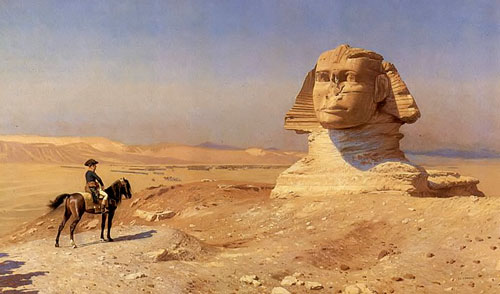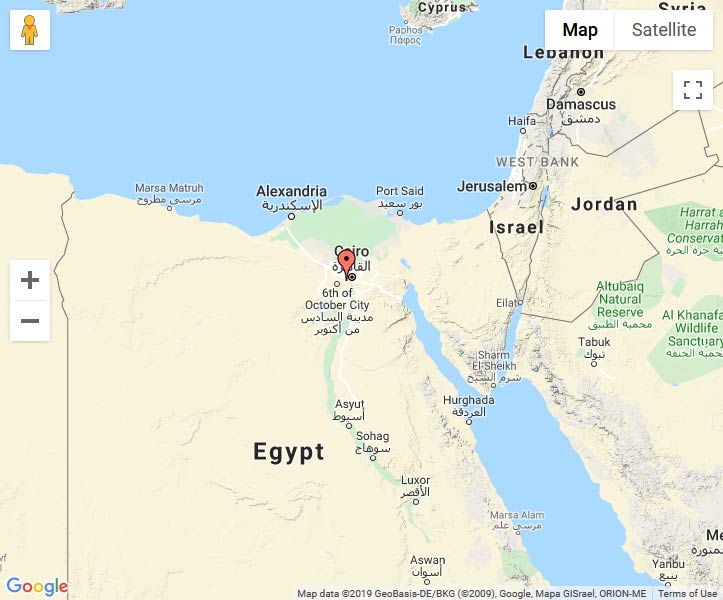Facts About the Great Sphinx of Egypt
The Sphinx has been a symbol of Egypt from ancient times to the present. It has inspired the imaginations of artists, poets, adventurers, scholars and travelers for centuries and has also inspired endless speculation about its age, its meaning and the secrets that it might hold.
A Description of the Great Sphinx
- The Great Sphinx of Giza is an immense stone sculpture of a creature with the body of a lion and the head of a human. The greatest monumental sculpture in the ancient world, it is carved out of a single ridge of limestone 240 feet (73 meters) long and 66 feet (20 meters) high.
- The Sphinx sits in a shallow depression to the south of the pyramid of the Pharaoh Khafre (also known as Chephren) at the west bank of the Nile River near the city of Cairo.
- The rock stratum out of which the Sphinx has been made varies from a soft yellowish to a hard grey limestone. The massive body is made of the softer stone, which is easily eroded, while the head is formed of the harder stone.
- To form the lower body of the Sphinx, enormous blocks of stone were quarried from the base rock and these blocks were then used in the core masonry of the temples directly in front and to the south of the Sphinx.
- Despite the hard quality of the stone of the head, the face is badly damaged, and not only by natural erosion. The nose is missing altogether and the eyes and the areas around them are seriously altered from their original state.
- Some scholars believe that the Great Sphinx originally had a beard. Pieces of this beard discovered by excavation are in the British Museum in London and the Cairo Museum. These pieces, however, may be dated to the New Kingdom times of
1570-1070 BCE. - The Sphinx is part of a complex of structures that also contains the Sphinx temple. This temple, like the Great Pyramid and the Oseiron temple at Abydos in Southern Egypt, may also date from Pre-dynastic times.
- Napoleon's artillerymen have been blamed for using the face of the Sphinx for target practice.
The History of the Sphinx
- According to orthodox Egyptology the Sphinx was constructed in the 4th Dynasty (2575 – 2467 BCE) by the Pharaoh Khafre. However, an accumulating body of evidence, both archaeological and geological, indicates that the Sphinx is far older than the 4th Dynasty and was only restored by Khafre during his reign.
- There are no inscriptions on the Sphinx, or on any of the temples connected to it that, that offer evidence of construction by Khafre. The so-called 'Inventory Stele' (uncovered on the Giza plateau in the 19th century) tells that the Pharaoh Khufu (Cheops) – Khafre’s predecessor - ordered a temple built alongside the Sphinx, meaning of course that the Sphinx was already there, and thus could not have been constructed by Khafre.
- A much greater age for the Sphinx has been suggested by R.A. Schwaller de Lubicz, based upon geological considerations. Schwaller de Lubicz observed, and recent geologists (such as Robert Schoch, Professor of Geology at Boston University) have confirmed, that the extreme erosion on the body of the Sphinx could not be the result of wind and sand, as has been universally assumed, but rather was the result of water.
- Geologists agree that in the distant past Egypt was subjected to severe flooding. Wind erosion cannot take place when the body of the Sphinx is covered by sand, and the Sphinx has been in this condition for nearly all of the last five thousand years - since the alleged time of its 4th Dynasty construction.
- If wind-blown sand were responsible for the deep erosion of the Sphinx, we would expect to find evidence of such erosion on other Egyptian monuments built of similar materials and exposed to the wind for a similar length of time. Yet the fact of the matter is, that even on structures that have had more exposure to the wind-blown sand, there are minimal effects of erosion, the sand having done little more than scour clean the surface of the dressed stones.
- The purpose of the Sphinx is not known. Some orthodox archaeologists assume that it was a memorial to a Pharaoh or that it functioned as some sort of talisman or guardian deity. Other scholars, however, believe the Sphinx functioned as an astronomical observation device that marked the position of the rising sun on the day of the spring equinox in the time of Leo the Lion, which lasted from 10,970 to 8810 BCE. This interpretation is given support by the leonine shape of the Sphinx.
- In 1798, when Napoleon came to Egypt the Sphinx was buried in sand up to its neck. Between 1816 and 1858, a series of adventurers and antiquarians, including Giovanni Caviglia, Auguste Mariette and Gaston Maspero, attempted to clear the sand from around the body of the Sphinx but were each forced to abandon the project due to the enormous amount of sand. Finally, between 1925 and 1936, the French engineer Emil Baraize was successful in clearing the sand to reveal the base of the Sphinx.
The Mystery of the Sphinx
- Edgar Cayce (1877-1945) the ‘sleeping prophet’ had the ability to put himself into a deep trance. He stated in some of his trances that Egypt was the repository for records of the alleged civilization of Atlantis, about 10,500 B.C. This repository was an underground library, called the Hall of Records," that contained the wisdom of Atlantis. Cayce claims that the Sphinx points in the direction of the "Hall of Records." His reading states: "There is a chamber or passage from the right forepaw of the [Sphinx] to this entrance of the Hall of records, or chamber."
- In the 1980’s and 1990’s the Edgar Cayce Foundation conducted research in Egypt around the Sphinx to verify Cayce’s reading. Although researchers from all over the world have begun to look for this chamber with very sophisticated instruments, they have not found the Hall of Records."
- There are three passages into or under the Sphinx, two of them of obscure origin. The one of known cause is a short dead-end shaft behind the head drilled in the nineteenth century. No other tunnels or chambers in or under the Sphinx are known to exist. A number of small holes in the Sphinx body may relate to scaffolding at the time of carving.
The Pre-Dynastic era age of the Sphinx
- Evidence suggesting a construction period for the Sphinx – greatly predating the 4th Dynasty - may perhaps be indicated by the astronomical significance of its shape, being that of a lion. Roughly every two thousand years (2160 to be exact), and because of the precession of the equinoxes, the sun on the spring equinox rises against the stellar background of a different constellation. For the past two thousand years that constellation has been Pisces the Fish, symbol of the Christian age. Prior to the age of Pisces it was the age of Aries the Ram, and before that it was the age of Taurus the Bull. It is interesting to note that during the first and second millennia BC, approximately the Age of Aries, ram-oriented iconography was common in Dynastic Egypt, while during the Age of Taurus the Bull-cult arose in Minoan Crete. Perhaps the builders of the Sphinx likewise used astrological symbolism in designing their monumental sculpture. Geological findings indicate that the Sphinx may have been sculpted sometime before 10,000 BC, and this period coincides with the Age of Leo the Lion, which lasted from 10,970 to 8810 BC.
- Further support for this vast age of the sphinx comes from a surprising sky-ground correlation proven by sophisticated computer programs such as Skyglobe 3.6. These computer programs are able to generate precise pictures of any portion of the night sky as seen from different places on earth at any time in the distant past or future. Graham Hancock explains in Heaven’s Mirror that, “computer simulations show that in 10,500 BC the constellation of Leo housed the sun on the spring equinox - i.e. an hour before dawn in that epoch Leo would have reclined due east along the horizon in the place where the sun would soon rise. This means that the lion-bodied Sphinx, with its due-east orientation, would have gazed directly on that morning at the one constellation in the sky that might reasonably be regarded as its own celestial counterpart.”
Restoration of the Sphinx
- Repairs to the Sphinx have been made over the centuries by the Pharaohs Tuthmosis IV and Ramesses II, and also during the Roman era. Restoration attempts have continued to the present time yet the Sphinx continues to deteriorate because of the relentless wind, humidity and the ever-increasing smog from nearby Cairo.
- In the 1980’s, during a six-year period, more than 2000 limestone blocks were added to the body of the Sphinx and various chemicals were injected in the hopes of preventing its further deterioration. This treatment was not successful and in fact contributed to the deterioration. In 1988 the left shoulder crumbled and blocks fell off. Present attempts at restoration are under the control of the Supreme Council of Antiquities' archaeologists.

Napoleon at the Sphinx in 1798

The Sphinx in the early 1900's
 Martin Gray is a cultural anthropologist, writer and photographer specializing in the study of pilgrimage traditions and sacred sites around the world. During a 40 year period he has visited more than 2000 pilgrimage places in 165 countries. The World Pilgrimage Guide at sacredsites.com is the most comprehensive source of information on this subject.
Martin Gray is a cultural anthropologist, writer and photographer specializing in the study of pilgrimage traditions and sacred sites around the world. During a 40 year period he has visited more than 2000 pilgrimage places in 165 countries. The World Pilgrimage Guide at sacredsites.com is the most comprehensive source of information on this subject.For additional information:
http://www.sacred-destinations.com/egypt/giza-sphinx
